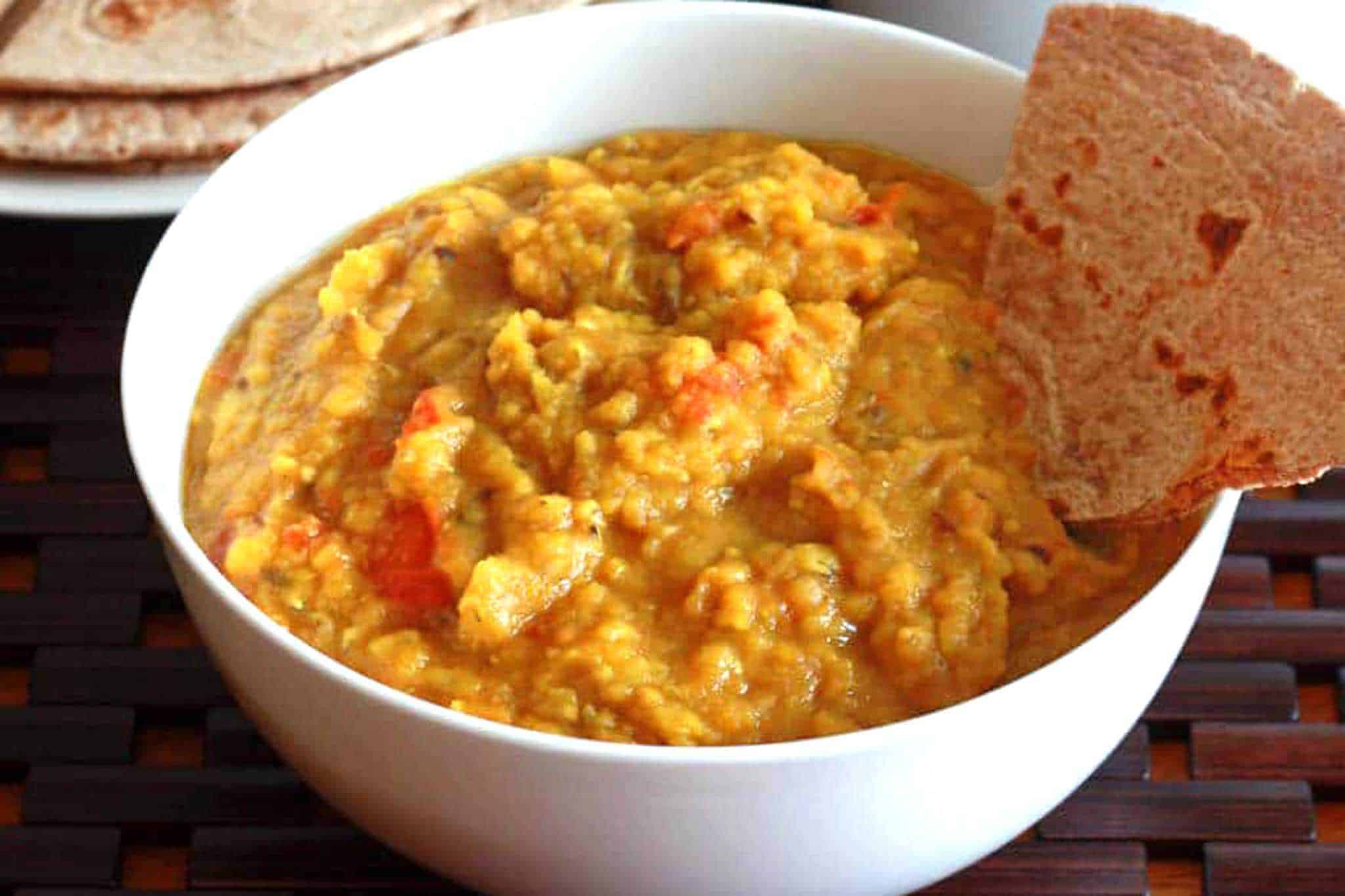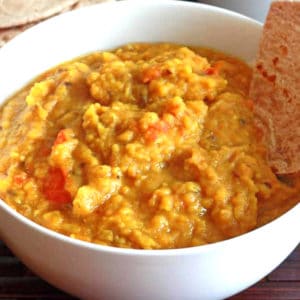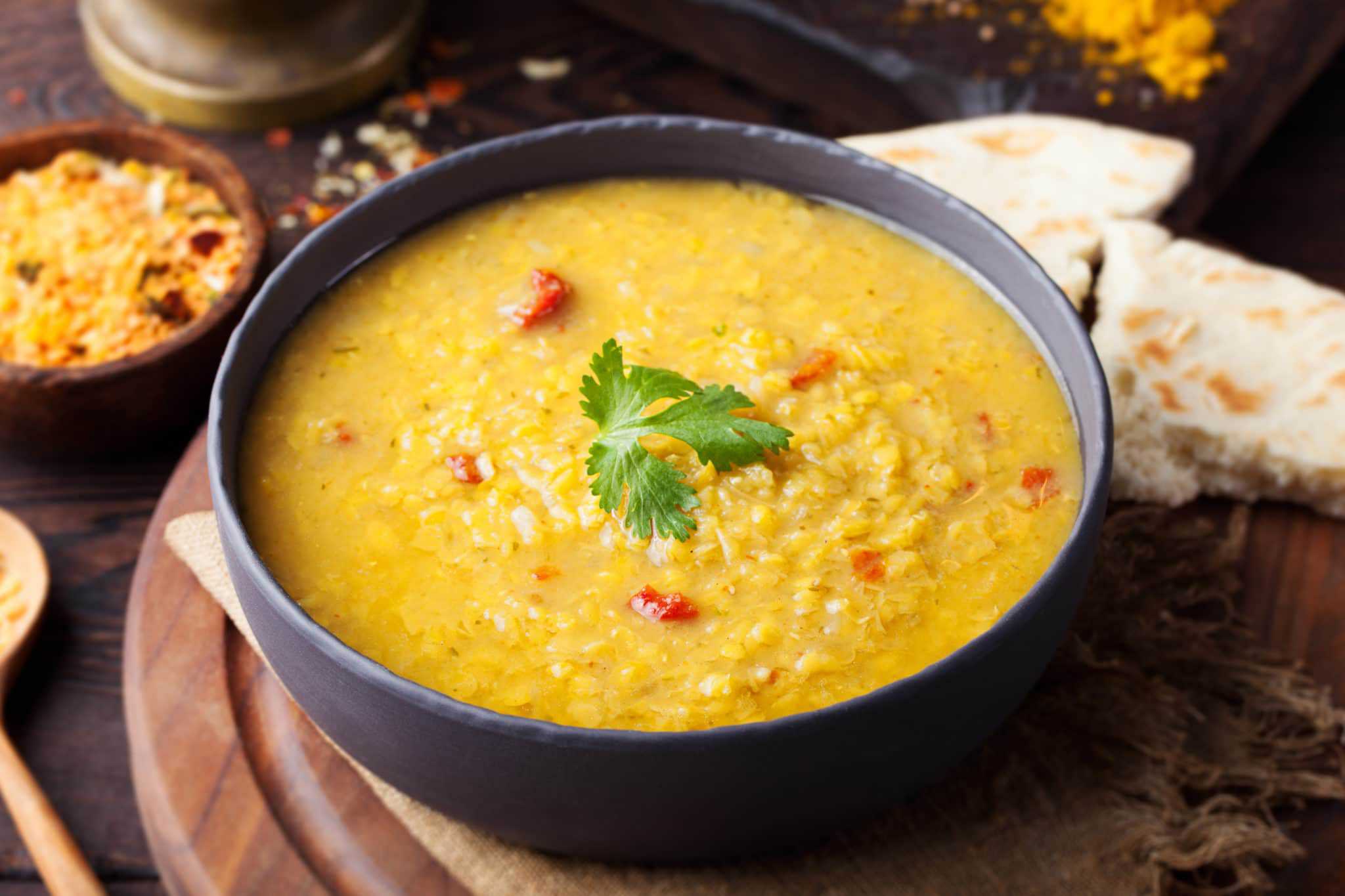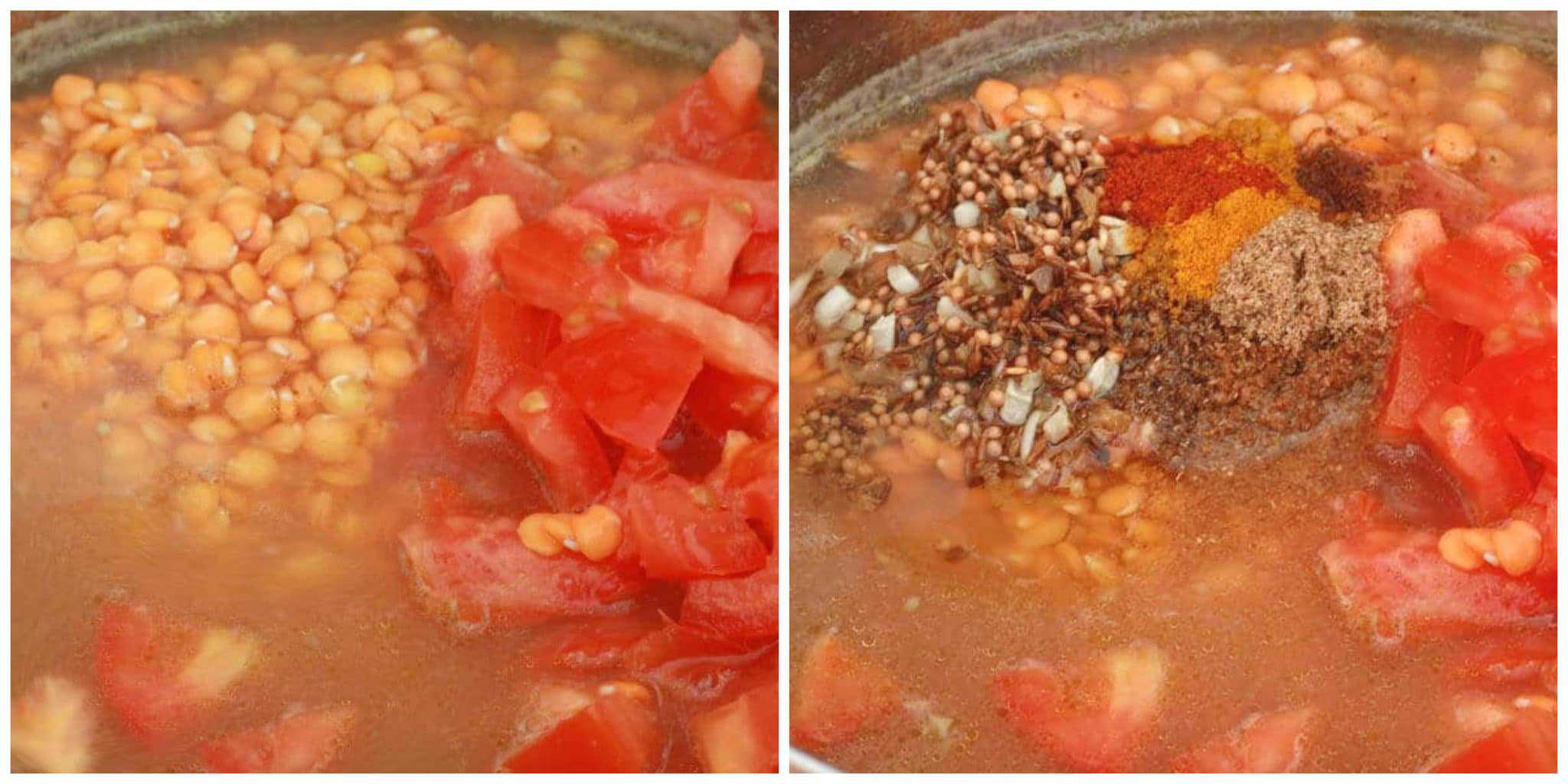Indian Red Lentil Dip
This post may contain affiliate links. See my disclosure policy.

If you think this sounds and looks familiar, you’re right! A while back I posted my recipe for Masoor Dal, an Indian red lentil soup. It’s my favorite Indian soup and I’ve discovered that the way I enjoy eating it best is as a dip. This is a thicker version of Masoor Dal and it makes the most splendid dip for various kinds of bread and vegetables. It’s a family favorite, from our one year old on up. This dip version is so good that it deserves a spotlight of its own.
Indian food is without question one of the most complex cuisines in the world. Multiple layers of flavor allure the palate in virtually every Indian dish. That’s in part because Indian cuisine is based upon various elements of Ayurvedic philosophy. I don’t pretend to know much about Aryuveda, but here it is with respect to food in a nutshell. Ayruveda’s aim is to restore and maintain balance within the body’s various systems in order to prevent disease and achieve optimal health and well-being. And this is achieved in large part through diet. Thus food is not only consumed for enjoyment but also as medicine. Ayurveda maintains that six tastes are required, in various proportions dependent on each person’s unique constitution, and those tastes are sweet, sour, salty, pungent, bitter, and astringent. This philosophy of achieving balance in different taste properties is also seen in Chinese cuisine. And herein lies the complexity of Indian cuisine: A lack of any of the six tastes will lead to an imbalance in the body’s systems and lead to various health conditions, both of body and mind. And so a balanced Indian meal will always include a spicy-sour combination along with something pungent like onion or garlic, a bitter component like fenugreek or lemon, something astringent like green vegetables or potatoes, and of course something sweet, whether it’s a chutney, some fruit, or dessert. So next time you eat out at an authentic, traditional Indian restaurant, pay attention to the careful preparation that goes into the meal.
This Indian Red Lentil Dip is simple in its ingredients but complex in its flavor because of the wonderful combination of ingredients and the variety of spices in it. For more information about some of these spices, including the mysterious and magical Asafoetida (aka Devil’s Dung!) see my post for the Masoor Dal recipe.
Let’s get started!
Heat the oil in a small skillet over high heat and add the mustard and cumin seeds. Fry until the mustard seeds begin to pop, about 10 seconds.
Reduce the heat to medium-high and add the chilies, garlic and ginger. Fry for another 20 seconds. Add the onion and fry until soft and a light caramelized brown, about 5-7 minutes.
Add the turmeric, chili powder, asaefoetida, coriander, turmeric, chile powder, cinnamon and cloves and stir to combine. (These ground spices can instead be added to the soup instead of to the whole spices in the pan. I’ve done it both ways but have found that adding them briefly to the pan will further coax the flavor out of them.)
Rinse the lentils and place them in a stock pot with the vegetable broth, tomatoes and salt.
Add the spice/garlic/ginger mixture to the stock pot.
Stir to combine. Bring the soup to a boil, reduce the heat to medium-low, cover and simmer for 20 minutes or until the lentils done. Add salt to taste.
Before serving, add the lime juice, a little at a time, according to taste. Add more salt as needed. Serve sprinkled with fresh chopped cilantro.
Serve warm or at room temperature with naan bread, toasted pita or flatbread, or vegetables.

Indian food lovers, don’t forget to try this recipe for the BEST Indian Mango Chutney!
Save This Recipe

Indian Red Lentil Dip
Ingredients
- 1 3/4 cups red lentils , thoroughly rinsed and drained
- 2 1/2 cups vegetable stock
- 2 tomatoes , diced
- 1 teaspoon salt
- 1 tablespoon extra virgin olive oil
- 1 teaspoon mustard seeds
- 1 teaspoon cumin seeds
- 1-2 green chilies , chopped (use more or less and discard seeds according to heat preference)
- 1 teaspoon chopped fresh ginger
- 1 teaspoon chopped fresh garlic
- ½ cup onion , finely chopped
- ¼ teaspoon asaefoetida , aka hing
- 2 teaspoons ground coriander
- ½ teaspoon turmeric
- Pinch of Kashmiri chili powder or cayenne pepper
- Small pinch of cinnamon
- Small pinch of cloves
- Juice of one lime
- Fresh chopped cilantro for serving
- Salt to taste
Instructions
- For the Dal: Place the rinsed lentils, vegetable stock, tomatoes, and salt in a stock pot.
- For the Chaunk: Heat the oil in a small skillet over high heat and add the mustard and cumin seeds. Fry until the mustard seeds begin to pop, about 10 seconds. Reduce the heat to medium-high and add the chilies, garlic and ginger. Fry for another 20 seconds. Add the onion and fry until soft and a light caramelized brown, about 5-7 minutes. Add the turmeric, chili powder, asaefoetida, coriander, cinnamon and cloves and stir to combine.
- Combine the Dal and Chaunk: Scrape the contents of the skillet into the stock pot. Stir to combine and bring it to a boil. Reduce the heat, cover, and simmer stirring occasionally for about 20 minutes or until the lentils are done are are a thick consistency.
- Before serving, add the lime juice, a little at a time, according to taste. Add more salt as needed. Serve sprinkled with fresh chopped cilantro.
- Serve warm or at room temperature with naan bread, toasted pita or flatbread, or vegetables.






















How much does this recipe yield? In part #2 you mention turmeric and chili powder twice. Is that a typo or do we add it in halves twice?
Hi!
First of all, when I typed in Indian recipe in Google, i was expecting to find an Indian website to tell me how to make my favorite dal. It did not, and I am glad it didn’t. :)
The recipe is perfect, and I cannot wait to try it. But what astounds me is your interest and knowledge of the Indian cuisine. I checked some other posts too, and cannot agree more on their authenticity. :) Hell, I even read things I don’t know about Indian food! I often hear people say that they like Indian cuisine, but cannot stand the spices. Well, this is THE reason I am astounded by your knowledge of it. :)
I have been living in Switzerland for about four months now, and I severely miss the home-cooked dal, and hopefully tomorrow I shall find peace within with this recipe. :)
Merry Christmas.
It will be a good Christmas for me too. :D
Thanks!
Piyush
Piyush, you’ve made my day :) Thank you! I’m thrilled you’ve found my site and hope you enjoy this dal as much as we do. Merry Christmas! -Kimberly
Hi Kimberly .. Kiran here ..
I hope you remember me from the besan ki barfi post – just updated some recipes for home made pander/Indian cottage cheese – so simple and yummy and a great meat alternative .. Kinda like tofu just tastier :-) .. And its also used for desserts but will try that next week ..
And I love the presentation of the daal – its something so simple for us and you have made it look so elegant .. And I love reading about your food from your perspective – you make it sound so yummy! ..
The ingredients are the same but we do it differently – we always temper in the end – cook the daal, and when its about to boil, heat oil, add the cumin and garlic and spices (different tempering for different daals) .. And then add it when the daal is boiling so it sizzles ..
And we have leftover daal we sometimes mix it up and do a new temper to freshen it up – a stock cube also enhances the flavor!
And the hing is smelly – we don’t use it everyday cooking, just rarely and mostly for making Dani badas – basically lentil fritters soaked in water with hing to make them soft then added in a yoghurt mixture ..
Hi Kiran, thank you, and welcome back! Thank you for all the information! I’m excited to check out your homemade paneer! Will head over to your blog shortly. Again, thanks so much! :)
The smell of asaefoetida makes me gag to the point where I have had to leave the store if there’s a large enough quantity of it on a shelf. No wrapping or packaging seems to contain the odor. And yet I’ve had dishes cooked with it that were delicious and with no discernible odor. So I am going to try this dish without, Thanks for posting the recipe.
You’re not alone in your sentiments, LS Gourmet. The love-hate relationship with asafoetida are centuries old, hence the completely contrasting names its been given: “Food of the Gods” and “Devil’s Dung”! While I wouldn’t exactly call it a food of the gods, I fall into the camp of those who like it. The smell doesn’t bother me at all. In fact, I like it. But I am curious about the extreme reaction you and other people have shared and so I’m going to try some other brands as a comparison to the one I typically use. Maybe I just got lucky with a much tamer version! In any case, yes, once it’s added to the food the odor tends to dissipate and you’re just left with the wonderfully unique flavor. But no, you don’t have to have asafoetida for this recipe – this dip is very wonderful even without. Thanks for stopping by and do let me know what you think once you’ve had the chance to try it this recipe!
This Dip looks so delicious and sounds so healthy, the ideal starter for a Dinner Party or for a Picnic… I love it! Have a nice weekend Kimberly. Warm regards, Bridget
Thanks so much, Bridget! You have a wonderful weekend, too! :)
Question: how important is the asafetida to the recipe? I had some of that in my kitchen years ago, and had to get rid of it because I could not tolerate the smell of it – the smell pervaded my kitchen. Apart from that, the recipe sounds wonderful.
Haha, yes I remember you mentioning that before! Really, you thought it was that bad?? The brand I use is pretty tame and I really enjoy the flavor. But no, it’s not essential at all. This recipe is fantastic even without it.
Yes, it was that bad. I am unfortunately very sensitive to some smells, and that one left me afraid to try it, even after 20 years or so. I guess I picked it up at an Indian grocery, not sure it had a brand. I would be willing to try the dish with asafetida in it, I just don’t want the spice in my house or to have to work with it… I’m glad it’s not essential. :-)
Is this native American indian soup
Hello! No, it is not Native American.